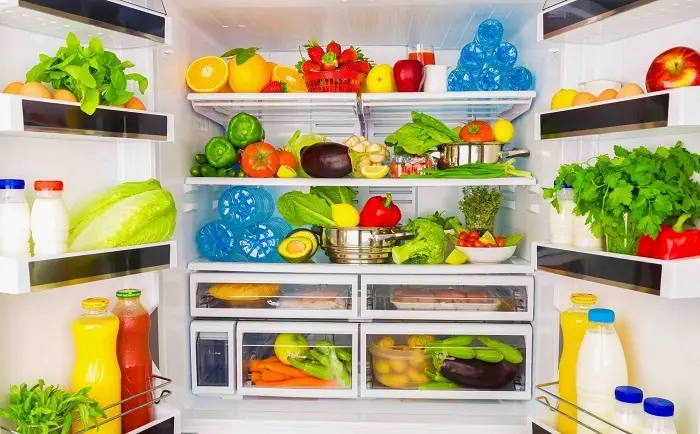How to Sanitize a Refrigerator (7 Steps to a Worry-Free Fridge)
From meal to meal—day to day—odor-causing residue and accidental waste is a constant battle inside the fridge for most homeowners and renters. Everyone endures the need to clean inside the fridge and to sanitize it on a regular basis.
At its worst, the forgotten waste and accidental residue inside the refrigerator can lead to foul-smelling, bad-looking, and illness inducing bacteria.
For this, renters and homeowners buckle up. They wear their thickest gloves and masks in order to address a fridge that has let itself go and where bacteria and food scraps have laid waste to the ideal order.
You, however, do not need to fear the bacteria and waste growing inside your fridge; you can achieve a kind of peaceful cleanliness at home by learning how to sanitize a refrigerator. In this post, we discuss the three key steps to cleaning and sanitizing that will make for a worry-free and cleanly fridge—as often as you would like.
How to Sanitize a Refrigerator, Without A Shadow of A Doubt
A particularly worrisome and odor-infested refrigerator will come to be from many factors including your fridge’s temperature, the frequency of use, and contents as well as whether you are able to keep up with it on a regular basis—to name just a few factors. The main source of a refrigerator in desperate need of cleaning and sanitizing, however, comes from the inability to attend to it regularly and improper cleaning methods.
While it is simple, not possible, for some homeowners and renters, to attend to a deep cleaning of the fridge as regularly as they would like; there are cleaning steps and hygienic tricks that will allow you to keep a clean and worry-free fridge for longer periods of time. In this way, you may find that you will not need to adjust your schedule to accommodate the constant sanitation and fresh smell of your refrigerator.
The essential knowledge of sanitation is simple: some technologies are better than others at removing bacteria, mold, and other threats from your fridge.
There are, for example, natural as well as chemical solutions to the problem of a dirty refrigerator such as hydrogen peroxide and bleach—all of which attack the DNA of bacteria and lead to a germ-free zone inside the fridge. Additionally, if you have the option, some people choose to invest in white vinegar and baking soda for gleaming surfaces and a fresh scent.
You may have tried on your own to clean and sanitize your fridge and experimented with different products to address the odor and appearance of an unmaintained refrigerator.
In the next section, we discuss all the requirements of our tutorial on how to clean and sanitize a refrigerator. When followed, this advice you will help you have a clean refrigerator every day you can eat off!
Requirements of Refrigerator Sanitation
You probably already have all the things you need for a worry-free refrigerator, but here are some items that you will want to check off your cleaning checklist before getting started, especially if this is your first time sanitizing a fridge.
- Cooler with Ice: The contents of your fridge are perishable, and while you are cleaning and sanitizing your refrigerator, you will want to protect your food from decay and spoilage by keeping a cooler with ice on hand for any sensitive items such as meat and dairy.
- Dish Detergent and Rags: You may not think that dish detergent is suitable for more than merely dishes and glasses, but you will be surprised by its effectiveness to deal with grease, stains, and food inside the plastic interior of your refrigerator as well. You, of course, you have your choice of brand and scent, but choosing a powerful, grease-fighting formula is best.
- Hydrogen Peroxide: Similar to chlorine bleach and other chemicals, hydrogen peroxide is a powerful and non-toxic sanitizer that will allow you to render your fridge a germ-free zone without the worry that you will contaminate your food with toxic chemicals. Otherwise, you may find that you run into the complication of needing to sanitize your fridge of over-potent sanitizers like ammonia that can lead to stomach irritation and serious health concerns.
- White Vinegar: The use of a simple, clean product like white vinegar is ideal for spot treatments to any chrome or reflective surfaces inside and outside of your refrigerator, allowing you to shine and polish in an environmentally-friendly and worry-free way.
- Baking Soda: As a final requirement, baking soda can be used to scrub tough to address spills and stains while also being left inside the fridge for a fresh, neutral scent since it naturally absorbs and reduces odors. It should probably not be baking soda that you plan to use for another purpose because it will begin to absorb the odors and molecules in the fridge that can turn your stomach.
Sanitizing your Refrigerator
Now that you understand the conditions and material requirements of sanitizing your refrigerator, you will easily see how the following steps to sanitizing will produce a spotless and food-friendly result in your refrigerator. Follow them exactly and in the order in which they appear for the best result.
- Remove all your food from the fridge, allowing you to clean every corner of it, and place the food in your container with ice.
- Next, remove all drawers and shelves, soaking them in a warm water mixture of dishwashing detergent while you move on to the next steps in this tutorial.
- Use water, dishwashing detergent, and clean rags to wipe down the entire inside of the refrigerator, including shelves, sides, and ceiling.
- Address stubborn stains and spills by scrubbing with baking soda.
- Use hydrogen peroxide and a fresh rag to wipe down all the surfaces of the refrigerator and produce a bacteria-free zone.
- Shine and polish any chrome or reflective surfaces with white vinegar.
- Replace your drawers, shelves, and food.
Final Thoughts
By following these simple steps, you will not find it difficult to produce a fresh, clean, and sanitized refrigerator as often as you would like. Bacteria and mold can be removed simple with the use of the right products (such as hydrogen peroxide), and freshness and appearance can be maintained just as well (with baking soda and white vinegar).
Whether you are looking for a refrigerator clean enough to eat off of or simply a sanitary fridge, follow our seven useful steps for a worry-free, sanitized refrigerator.

